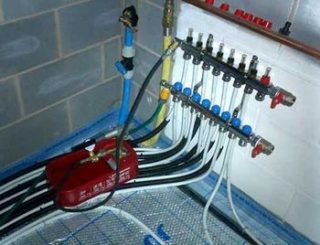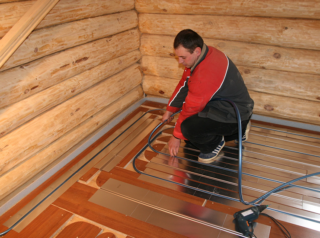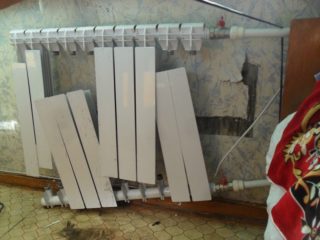For a heating system to be reliable and energy efficient, it is not enough to carry out a high-quality design and installation. It is important to carry out commissioning work in a timely and correct manner, which includes crimping the heating system and flushing it. The procedure of mandatory technical control is carried out at the end of the installation of a new heating system, at the beginning of the heating season and after repairs. In apartment buildings, similar work is carried out by competent organizations. In a private house, the performance of the heating system can be checked independently. This will require special equipment and knowledge of the requirements of regulatory acts governing the maximum pressure for the system and the time interval for testing different heating networks.
Test Features
Pressure testing of heating pipes is the final stage after installing a new or repairing an existing system before signing the act of completion.
The procedure involves testing by injecting air or liquid into the pipes under standard pressure, which exceeds the working pressure by several times. For a private house, this way checks:
- contours of the warm floor;
- heating radiators;
- collectors;
- locking fittings;
- points of connection of pipes to equipment;
- circulation pumps;
- boilers;
- boilers.
Such a check clearly demonstrates the quality of the material used and shows whether the selected equipment and pipes can withstand high pressure while maintaining tightness at the connection points. With a positive test result, heating can be started in the normal mode, without fear of emergency situations.
According to the rules, pressure testing of the heating system is carried out in conditions of positive temperature on the street. Indoor temperature should not be lower than 5 degrees. At low temperatures, pressure testing is carried out only in emergency cases.
Requirements of SNiP 41-01-2003
The requirements of this regulatory document state that the conduct of hydraulic tests inside the premises should take place in conditions of positive air temperature. Water systems must withstand pressure of at least 0.6 MPa, without collapsing and without losing tightness.
During testing, the pressure should not exceed the limit value set for the pipeline, fittings and heating devices.
When performing hydraulic crimping, water is pumped into the pipeline and using special equipment, hydraulic pressure is created that exceeds the standard indicator by 1.5-2 times. In this state, the system is left for the necessary time during which observation is performed in order to detect leaks. When checking plastic pipes, they first hold the working pressure for 2 hours, and at the third hour they increase the pressure by 30%.
The maximum pressure indicator during hydraulic pressure testing of the heating system and batteries is 10 bar, provided that the elements to be tested for this pressure are initially calculated.
Requirements of SNiP 3.05.01–85
The requirements of this normative document indicate that the pressure test of the thermal unit of the water heating system is carried out hydraulically, increasing the pressure by 1.5 times from the operating value.Within 5 minutes, the inspected area must withstand such pressure without violating the integrity and formation of leaks - this means that it has passed the test and is ready for normal operation.
Conditions for crimping
Pressure testing of the heating was performed correctly and in full, if during its implementation all conditions were met:
- During testing, it is not allowed to carry out other work at the facility.
- If a specialized company performs pressure testing of the heating system and radiators, it must act in accordance with the plan agreed by the leading engineer. The instruction should contain information on forthcoming works, their sequence and equipment used.
- The presence of persons other than specialists conducting tests at the facility, its inclusion and shutdown is not allowed.
- If at the same time tests are carried out at adjacent facilities, it is important to ensure the safety of their conduct.
A visual assessment of the operation of heating devices in the process of checking them should only be carried out under operating pressure. At the end of the work, an act is drawn up confirming the tightness of the heating system.
Types of tests and their time
The leak test of the heating unit is carried out in the following situations:
- In a private house, an initial system check is performed at the stage of preparing the house for commissioning. Pipeline diagnostics in gates and underfloor heating circuits are carried out before sealing and filling the screed. When the mortar has completely dried, it is recommended that additional hydraulic tests be carried out to identify and eliminate possible leaks before laying expensive finishing material.
- To prepare the heat supply network for unplanned switching on once a year after the end of the heating season, a periodic hydraulic test is carried out. Also, the check is carried out immediately before the start of the heating season at positive ambient temperatures.
- One-off extraordinary checks of the strength and tightness of the system follow immediately after the completion of scheduled and unscheduled repair activities.
All these measures are diagnostic in nature and allow you to timely identify problems with the heating system, leading to its shutdown and repair.
Crimping process

The pressure that is used in the heating system is selected depending on its purpose and type of equipment. For pressure testing of input nodes, a pressure of 16 atm is used, for a heating system of a multi-storey building - 10 atm, for a private house - 2-6 atm.
When crimping, the deterioration of the building and heating system should be taken into account. In new buildings, testing is performed with a pressure excess of 1.5 - 2 times, and in dilapidated houses no more than 1.5. If the radiators are made of cast iron, during the test the pressure may not exceed the limit of 6 atm. For convectors, this value is 10 atm.
The decisive criterion when choosing a pressure in the process of checking the system are the parameters reflected in the technical data sheet of the equipment. The “weakest” part of the system is taken as a reference point.
Work sequence
Crimping takes place according to a single algorithm, which is as follows:
- If the work is carried out in a private house with autonomous heating, the boiler is turned off. Turn off the area of the heating system to be checked.
- Drain the water.
- The pipeline is filled with water, the temperature of which does not exceed 45 degrees. While filling takes place, air is removed from the system.
- Special equipment is connected to the system - the heating pressure test, with which pressure is pumped up to the operating indicator.In this case, a visual inspection of the inspected area is carried out.
- Perform a smooth increase in pressure to the value indicated in the test plan. Perform a visual inspection of the system for leaks and damage.
- The resulting value is fixed for 10 minutes using a manometer. Indications are recorded. If it remains unchanged, then the system is tight and ready for operation.
The pneumatic check method is used if the hydraulic method cannot be used. For example, at subzero temperature. A reference point for detecting a violation of the tightness of the pipeline is the pressure gauge. The places of possible leakage are determined by treating them with soapy water.
Permissible test pressure
According to regulatory documents, the pressure during the leak test of heating equipment should be:
- for domestic hot water and heating systems with a water heater - 10 atm;
- with convector heating - 10 atm;
- for cast iron and steel radiators - 6 atm.
The following testifies to successful passing of the equipment:
- during the tests no fogging of heating equipment was detected - boilers, pipes, radiators, valves and joints;
- after 5 minutes, the pressure inside the circuit decreased by no more than 0.2 bar;
- in 10 minutes in a hot water supply system consisting of metal pipes, the pressure drop did not exceed 0.5 bar;
- if the pipes are plastic, the normal indicator is a decrease in pressure to 0.6 bar in the first 30 minutes, and to 0.2 bar in the next 2 hours;
- during air tests of steam heating, the pressure in the first 5 minutes should drop by no more than 0.1 bar.
When testing a DHW system, 5 atm can be added to the operating pressure. When choosing a pressure exceeding the operating indicator, the data in the equipment passport are taken into account.
Types of Testing Pumps
Testing activities are carried out using manual or electric pumps to pressurize.
Manual models are equipped with pressure control devices, a tap for cutting off incoming water and a shut-off valve for draining water from a rectangular cell. A plunger pump is used to pump water under pressure. The main disadvantage of manual equipment is the low injection speed and the complexity of the process.
The best choice would be electrical equipment. Its advantage lies in the high speed of filling the circuits and in the automatic shutdown when the required pressure is reached.






